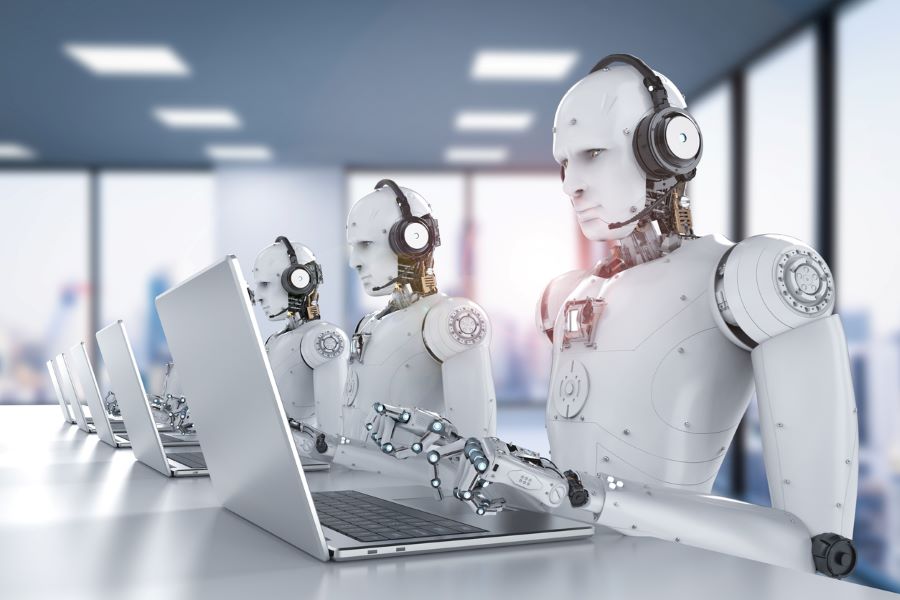
The rise of Artificial Intelligence (AI) has sparked a major conversation about the future of work. Will robots render human labor obsolete, or will AI become a powerful tool to empower us? From self-driving cars to automated customer service chatbots, AI is already transforming industries. But the reality is far more nuanced than a simple replacement story. As we look ahead, the true potential lies in humans and AI working together. This partnership will redefine work, not eliminate it. Imagine a doctor leveraging AI analysis to diagnose illnesses faster or a construction worker using AI-powered tools to ensure precise building plans. The future of work is not about humans versus AI, but about humans and AI working in tandem to create a more efficient, innovative, and ultimately, human-centered future.
AI is rapidly evolving and impacting the job market, but it’s important to understand that complete replacement isn’t always the case. However, there are quite a few jobs that can well be automated and humans will be replaced, and at the same time more jobs will be created where human intelligence and presence is needed more than code and machines.
In a recent research by Henley Wing Chiu, it’s evident that some jobs are particularly susceptible to automation and we’re seeing the human replacement on these right now.
“Writing jobs declined by 33%, translation jobs declined by 19%, and customer service jobs declined by 16%, all from November 1, 2022, to February 14, 2024.” (source: Entrepreneur)
Here’s a breakdown of jobs most likely to be affected by AI:
High Risk of Automation
-
Data Entry and Bookkeeping: AI can now handle vast amounts of data entry with high accuracy, automating tasks like filling out forms, processing invoices, and maintaining databases. Bookkeeping tasks like recording transactions, reconciling accounts, and generating reports are also prime targets for AI automation due to their repetitive nature.
-
Basic Customer Service Interactions: Chatbots powered by AI can answer frequently asked questions, troubleshoot basic problems, and even handle simple transactions. This could reduce the need for human customer service representatives for tasks like resetting passwords or providing basic product information.
-
Assembly Line Work in Manufacturing: Robots with advanced dexterity and machine learning capabilities are increasingly performing tasks like welding, painting, and assembling components on factory assembly lines. While some human oversight and maintenance will likely remain necessary, AI significantly reduces the need for manual labor in these settings.
Medium Risk of Automation
-
Manufacturing and Logistics Quality Control: AI-powered image recognition and machine vision can be used to inspect products for defects on production lines. This can automate quality control processes that were previously performed by human inspectors.
-
Delivery Drivers on Fixed Routes: Self-driving vehicles are still under development, but they have the potential to disrupt jobs like long-haul truck driving or deliveries on predefined routes. However, human drivers will likely remain essential for deliveries requiring navigation in complex environments or situations demanding on-the-spot decision-making.
-
Telemarketing and Sales in Specific Industries: AI-powered chatbots can qualify leads, answer basic sales questions, and even close simple transactions. This could reduce the need for telemarketers and salespeople in industries with standardized products and well-defined sales processes.
Lower Risk, Likely Augmented by AI
-
Content Creation: AI can assist with content creation by generating content ideas, providing summaries of factual topics, or translating languages. However, human creativity, critical thinking skills, and editorial judgment will remain essential for crafting high-quality content that resonates with a target audience.
-
Financial Analysis: AI can analyze vast amounts of financial data, identify trends, and even generate basic investment reports. However, human expertise in areas like portfolio management, risk assessment, and understanding client needs will remain crucial for roles like investment banking and wealth management.
-
Legal Research and Document Review: AI can be used for legal research, summarizing legal documents, and identifying relevant case law. However, human lawyers will remain irreplaceable for tasks requiring legal strategy, complex legal arguments, and client interaction in courtrooms or negotiations.
The key takeaway here is that AI is more likely to complement human work by automating repetitive tasks. This frees up professionals to focus on higher-level skills like strategic thinking, creativity, complex problem-solving, and human interaction – areas where human capabilities are (and likely will remain) unmatched. The future of work will involve collaboration – with AI handling the mundane and humans bringing their unique talents to the table.
Ready to explore other possible careers in AI in different industries? Check out this blog post: Navigating the AI Job Landscape: Industries at the Forefront of Hiring in 2024

